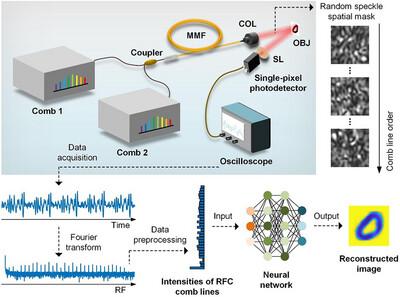双光学频率梳辅助下每秒超过千兆像素的无扫描散斑编码单像素成像
IF 10
1区 物理与天体物理
Q1 OPTICS
引用次数: 0
摘要
单像素成像(SPI)已经成为一种强大的成像技术,它可以从单个探测器检测到的1D信号中重建2D图像。大多数SPI系统受限于扫描范式来获取一维信号,这将成像帧率限制在空间光调制器或可调光源的调制速度。为了解决低成像率的挑战,提出了一种无扫描散斑编码SPI (SSE‐SPI)方法,该方法利用了散斑编码和双光学频率梳(dofc)的优点。由无序结构生成的空间散斑编码掩模有利于高压缩率,实现快速成像。此外,dofc可以并行部署空间散斑编码掩码,从而克服了与串行扫描过程相关的限制。通过消除扫描机制,通过应用人工神经网络进行图像重建,展示了高达20 MHz的离线成像帧率和15.68千兆像素/秒的大量时空信息通量。这种SSE - SPI方案有望实现单探测器的超快成像,并为材料科学和生命科学领域的瞬态过程捕获开辟了新的可能性。本文章由计算机程序翻译,如有差异,请以英文原文为准。

Scan‐Less Speckle Encoded Single‐Pixel Imaging over Giga‐Pixels Per Second Assisted by Dual Optical Frequency Combs
Single‐pixel imaging (SPI) has emerged as a powerful imaging technique that reconstructs 2D images from 1D signals detected by a single detector. Most SPI systems are constrained by a scanning paradigm to acquire the 1D signal, which limits the imaging frame rate to the modulation speed of spatial light modulators or tunable light sources. To address the challenge of low imaging rates, a scan‐less speckle encoded SPI (SSE‐SPI) approach is proposed that leverages the advantages of speckle encoding and dual optical frequency combs (DOFCs). The spatial speckle encoding mask, generated from a disordered structure, facilitates high compression rates, enabling rapid imaging. Additionally, DOFCs can deploy spatial speckle encoding masks in parallel, thereby overcoming the limitations associated with the serial scanning process. By eliminating the scanning mechanism, an offline imaging frame rate of up to 20 MHz and a substantial spatial‐temporal information flux of 15.68 giga‐pixels per second are demonstrated through the application of an artificial neural network for image reconstruction. This SSE‐SPI scheme holds promise for ultrafast imaging with a single detector and opens new possibilities for capturing transient processes in the fields of material science and life science.
求助全文
通过发布文献求助,成功后即可免费获取论文全文。
去求助
来源期刊
CiteScore
14.20
自引率
5.50%
发文量
314
审稿时长
2 months
期刊介绍:
Laser & Photonics Reviews is a reputable journal that publishes high-quality Reviews, original Research Articles, and Perspectives in the field of photonics and optics. It covers both theoretical and experimental aspects, including recent groundbreaking research, specific advancements, and innovative applications.
As evidence of its impact and recognition, Laser & Photonics Reviews boasts a remarkable 2022 Impact Factor of 11.0, according to the Journal Citation Reports from Clarivate Analytics (2023). Moreover, it holds impressive rankings in the InCites Journal Citation Reports: in 2021, it was ranked 6th out of 101 in the field of Optics, 15th out of 161 in Applied Physics, and 12th out of 69 in Condensed Matter Physics.
The journal uses the ISSN numbers 1863-8880 for print and 1863-8899 for online publications.

 求助内容:
求助内容: 应助结果提醒方式:
应助结果提醒方式:


